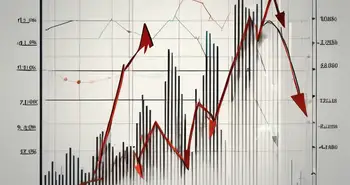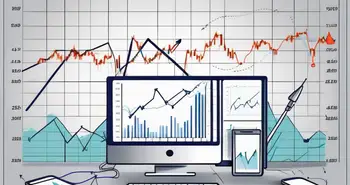Strategic Horizon: Long-Term Trading

Long term trading is a powerful strategy that can yield significant returns. Whether you're a seasoned investor or just starting out, understanding the ins and outs of long term trading is essential for success. In this comprehensive guide, I will walk you through the basics, help you develop a winning strategy, and provide valuable insights into technical and fundamental analysis. So let's dive in and explore the world of long term trading together!
Understanding the Basics of Long Term Trading
Before we jump into the nitty-gritty, let's first define what long term trading actually means.
Defining Long Term Trading: Long term trading refers to holding onto investments for an extended period, typically years rather than days or weeks. It is characterized by a focus on the fundamentals of a company or asset, rather than short-term price fluctuations.
The Importance of Long Term Trading: Long term trading allows you to capitalize on the overall growth potential of a company or market, while also avoiding the noise and volatility of short-term trading. It enables you to make informed investment decisions based on in-depth research and analysis.
Key Principles of Long Term Trading: Patience, discipline, and a long-term mindset are the cornerstones of successful long term trading. It involves careful evaluation of a company's financial health, industry trends, and market conditions to identify promising investment opportunities.
One of the key advantages of long term trading is the ability to benefit from compounding returns. By reinvesting dividends and allowing your investments to grow over time, you can potentially see significant wealth accumulation. This approach aligns with the famous quote by legendary investor Warren Buffett, “Our favorite holding period is forever.”
Furthermore, long term trading is not just about buying and holding onto investments passively. It also involves periodically reviewing your portfolio to ensure it remains aligned with your financial goals and risk tolerance. Rebalancing your holdings, adding new positions, or trimming underperforming assets are all part of actively managing a long term investment strategy.
Developing a Long Term Trading Strategy
Now that you understand the basics, it's time to develop a solid trading strategy.
Setting Your Trading Goals: Start by identifying your financial goals and risk tolerance. Are you looking for steady income, capital appreciation, or a mix of both? Define clear objectives that align with your long term vision and time horizon.
Choosing the Right Trading Instruments: Once you have your goals in place, it's essential to select the right trading instruments. Whether it's stocks, bonds, ETFs, or options, ensure that your chosen assets align with your investment objectives and risk tolerance.
Risk Management in Long Term Trading: Long term trading doesn't mean you can ignore risk. Implementing proper risk management techniques, such as diversification, setting stop-loss orders, and maintaining a well-balanced portfolio, is crucial to protect your investments and minimize potential losses.
Market Analysis and Research: Conduct thorough market analysis and research before making any trading decisions. Stay informed about economic indicators, company performance, industry trends, and geopolitical events that could impact the financial markets. Utilize both fundamental and technical analysis to make well-informed trading choices.
Emotional Discipline and Patience: Emotions can often cloud judgment in trading. Develop emotional discipline and patience to avoid making impulsive decisions based on fear or greed. Stick to your trading plan and avoid chasing quick profits or trying to time the market, as these behaviors can lead to costly mistakes.
Technical Analysis for Long Term Trading
While long term trading emphasizes fundamentals, incorporating technical analysis can provide valuable insights.
When delving into technical analysis for long term trading, it's essential to understand the intricate world of price movements and market psychology. By combining fundamental analysis with technical tools, traders can gain a comprehensive view of the market and make well-informed decisions.
Understanding Chart Patterns: Chart patterns, such as support and resistance levels, trend lines, and moving averages, can help you identify potential buying or selling opportunities. Recognizing these patterns not only aids in spotting entry and exit points but also assists in understanding market sentiment and investor behavior.
Moreover, delving deeper into chart patterns unveils a fascinating realm of shapes and formations that reflect the ongoing battle between buyers and sellers. From classic patterns like head and shoulders to more complex ones such as triangles and flags, each pattern tells a unique story about the market's current state and potential future direction.
Using Technical Indicators: Technical indicators, such as the relative strength index (RSI), moving average convergence divergence (MACD), and stochastic oscillators, can provide additional confirmation signals on potential market reversals or trends. These indicators help you make informed decisions based on historical price data.
Furthermore, mastering the art of technical indicators involves not only understanding their calculations and interpretations but also grasping their limitations. While these tools can offer valuable insights, they are not foolproof and should be used in conjunction with other forms of analysis to validate trading decisions.
The Role of Volume in Trading: Volume is a crucial technical indicator that gauges market interest and participation. Analyzing volume trends alongside price movements can provide insights into market sentiment and the strength of a particular trend.
By paying attention to volume patterns, traders can uncover hidden clues about the sustainability of price movements. Sudden spikes in volume can signal potential trend reversals or breakouts, indicating shifts in market dynamics that may not be evident from price action alone. Understanding the interplay between price and volume is key to deciphering the underlying market forces at play.
Fundamental Analysis for Long Term Trading
Long term trading relies heavily on fundamental analysis to assess the financial health and growth prospects of a company.
Economic Indicators and Their Impact: Economic indicators, such as GDP growth, inflation rates, and interest rates, play a crucial role in determining the overall market conditions and potential opportunities. Understanding how these indicators impact your investments is essential for long term traders.
The Role of Corporate Earnings: Evaluating a company's financial statements, including revenue, earnings per share (EPS), and cash flow, provides valuable insights into its financial stability and growth potential. Monitoring the quarterly and annual reports of your investments is essential for long term success.
Understanding Market Cycles: Markets go through various cycles, including bull and bear markets, as well as periods of consolidation. Recognizing these cycles and adjusting your investment strategy accordingly can help you navigate the volatile nature of the markets with confidence.
With these key insights and strategies, you're well on your way to becoming a successful long term trader. Remember, investing is a journey, and it's important to stay calm, focused, and disciplined. Now, it's time for my personal advice.
Personal Advice from an Expert:
Throughout my years as a long term trader, one piece of advice has always resonated with me: focus on the long-term vision rather than short-term noise. It's easy to get caught up in daily market fluctuations and breaking news. But remember, successful long term trading requires a patient and disciplined approach. Stick to your strategy, trust your research, and have faith in the potential of your investments.
FAQ
What is long term trading?
Long term trading refers to holding onto investments for an extended period, typically years rather than days or weeks. It focuses on the fundamentals of a company or asset rather than short-term price fluctuations.
What are the key principles of long term trading?
The key principles of long term trading include patience, discipline, and a long-term mindset. It involves careful evaluation of a company's financial health, industry trends, and market conditions.
How do I develop a long term trading strategy?
To develop a long term trading strategy, start by setting clear trading goals, choose the right trading instruments, and implement proper risk management techniques.
What is the role of technical analysis in long term trading?
While long term trading focuses on fundamentals, technical analysis can provide valuable insights into timing trades. Understanding chart patterns, technical indicators, and volume trends can enhance your trading decisions.
Why is fundamental analysis important in long term trading?
Fundamental analysis helps assess a company's financial health and growth potential. By analyzing economic indicators, corporate earnings, and market cycles, you can make informed long term investment decisions.
With this ultimate guide, you now have the knowledge and tools to embark on your long term trading journey. Remember, success in long term trading comes with experience, continuous learning, and a strategic approach. So, get started, stay patient, and watch your investments grow over time!
Ready to take your long term trading to the next level? Experience the future of investing with Morpher, the revolutionary trading platform that leverages blockchain technology for zero fees, infinite liquidity, and a truly unique trading experience. Whether you're interested in stocks, cryptocurrencies, or even niche markets like NFTs, Morpher's fractional investing, short selling capabilities, and up to 10x leverage have got you covered. Sign up now to gain control over your investments with Morpher's non-custodial wallet and get your free sign up bonus to start your journey. Embrace the innovation of trading on the Ethereum Blockchain with Morpher and watch your long term investments transform.

Disclaimer: All investments involve risk, and the past performance of a security, industry, sector, market, financial product, trading strategy, or individual’s trading does not guarantee future results or returns. Investors are fully responsible for any investment decisions they make. Such decisions should be based solely on an evaluation of their financial circumstances, investment objectives, risk tolerance, and liquidity needs. This post does not constitute investment advice.

Painless trading for everyone
Hundreds of markets all in one place - Apple, Bitcoin, Gold, Watches, NFTs, Sneakers and so much more.

Painless trading for everyone
Hundreds of markets all in one place - Apple, Bitcoin, Gold, Watches, NFTs, Sneakers and so much more.









